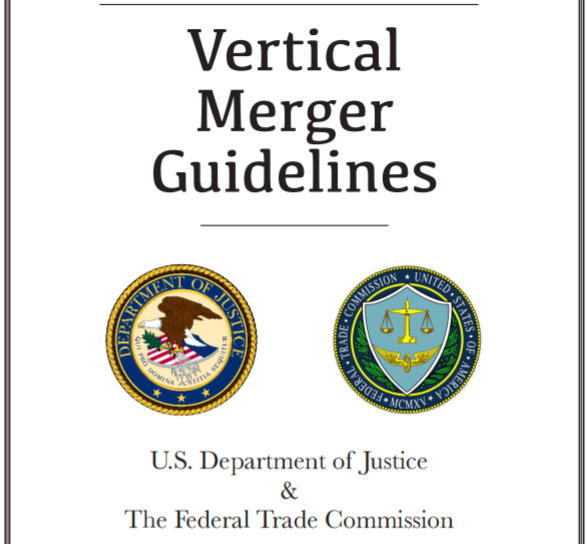Trump Administration Updates Vertical Merger Guidelines
The Trump Administration has released its new internal guidelines for how the relevant agencies will review vertical mergers, with an eye toward better identifying and challenging competitively harmful mergers, though critics of the process say the guidelines still keep a thumb on scale for such mergers.

Vertical mergers are ones that combine different parts of the same supply chain, an AT&T with its video services and Time Warner with its content production, for example, which DOJ tried unsuccessfully to block.
The Justice Department and Federal Trade Commission divvy up merger antitrust reviews, with Justice usually getting the media mergers. This is the first time they have issued joint guidelines and the first major revision since 1984.
The two have been working on a draft of new rules for some time, including putting them out for public comment. The FTC vote to release the new guidelines was 3-2 along party lines, with Democratic commissioners Rohit Chopra and Rebecca Kelly Slaughter voting no.
Related: DOJ, FTC Schedule Vertical Merger Workshops
Historically, vertical mergers have not frequently been challenged, but Department of Justice antitrust chief Makan Delrahim has made it clear there remain antitrust issues with vertical mergers, as was evidence by Justice's attempt to block the AT&T-Time Warner deal.
“These new Vertical Merger Guidelines provide transparency in the important area of vertical merger analysis,” said Delrahim.
Multichannel Newsletter
The smarter way to stay on top of the multichannel video marketplace. Sign up below.
FTC chairman Joe Simons called them "an important step forward in maintaining vigorous antitrust enforcement," and said they "reaffirm our commitment to challenge vertical mergers that are anticompetitive and would harm American consumers." But he also said they essentially reflect current enforcement policy, and in that sense are a transparency move to give businesses a heads up.
In her dissent, commissioner Slaughter said one reason she voted "no" was that the guidelines refused to explicitly disavow the "false assertion" that vertical mergers are almost always pro-competitive.
She did say there were positive changes including eliminating the "quasi-safe" harbor based on market share. The draft guidelines had signaled that a vertical merger is unlikely to be challenged if the merged parties have less than a 20% share of the market, as well as its discussion of raising rival's distribution costs as a potential competitive harm, which was a key point in DOJ's attempt to block AT&T-Time Warner, as well as its discussion of the purchase of firms that are the most likely potential competitors. That has been a key DOJ concern with Big Tech firms and whether they had bought themselves up to monopoly by purchasing potential rivals early, before it raises antitrust review. More than one venture capital-backed tech startup has launched in hopes of getting bought out for big bucks.
Where the guidelines fell short, she said, were "(1) the over-emphasis of the benefits of vertical mergers; (2) failure to identify merger characteristics that are most likely to be problematic; (3) the treatment of the elimination of double marginalization (“EDM”); and (4) the omission of important competition concerns including buy-side power, regulatory evasion, and remedies."
Related: DOJ, FTC Spar Over Roles in Antitrust Reviews
Delrahim signaled this week that the revision is basically updating the guidelines to square with its investigative practices and approach over the past few years, as a way to provide "greater predictability."
Joshua Stager, senior counsel for New America’s Open Technology Institute, agreed with Slaughter that the guidelines were underwhelming, calling it a missed opportunity for real change. OTI opposed the Comcast/NBCU, AT&T/DirecTV and AT&T/Time Warner deals, all of which passed muster, either with the relevant administration or the courts.
“These guidelines haven't changed since 1984, during which time competition has waned and inequality has worsened," Stager said. "We hoped the FTC and DOJ would use this process to make our antitrust laws work better for the American people. Unfortunately, the new guidelines miss the mark. Rather than refresh outdated thinking, the new guidelines gloss over critical issues and ignore the risks of vertical mergers, particularly in digital markets."
Contributing editor John Eggerton has been an editor and/or writer on media regulation, legislation and policy for over four decades, including covering the FCC, FTC, Congress, the major media trade associations, and the federal courts. In addition to Multichannel News and Broadcasting + Cable, his work has appeared in Radio World, TV Technology, TV Fax, This Week in Consumer Electronics, Variety and the Encyclopedia Britannica.

